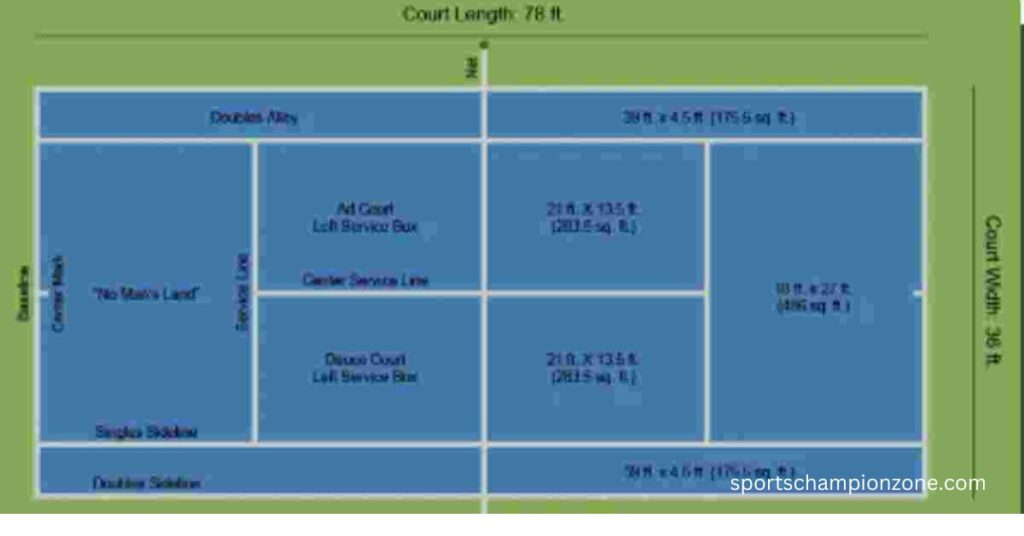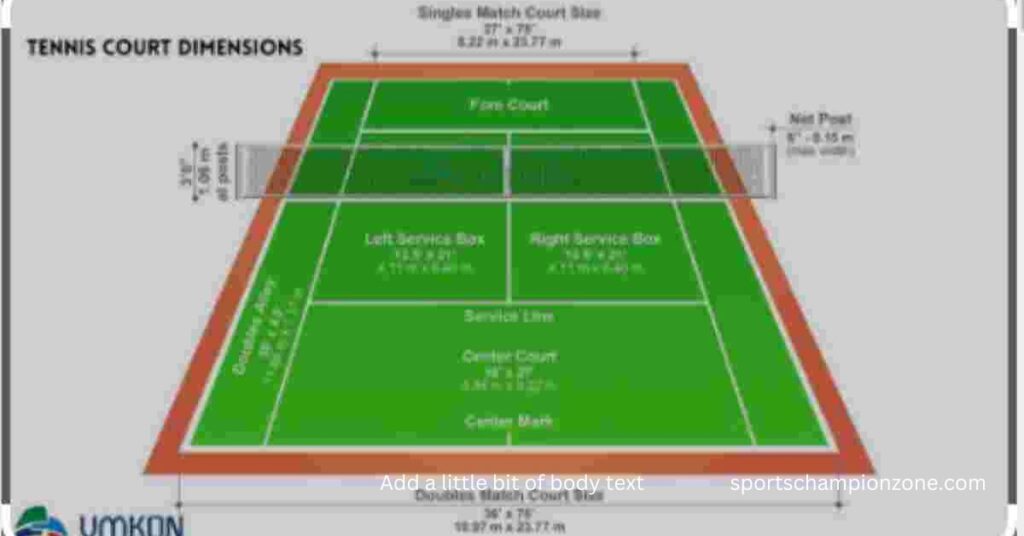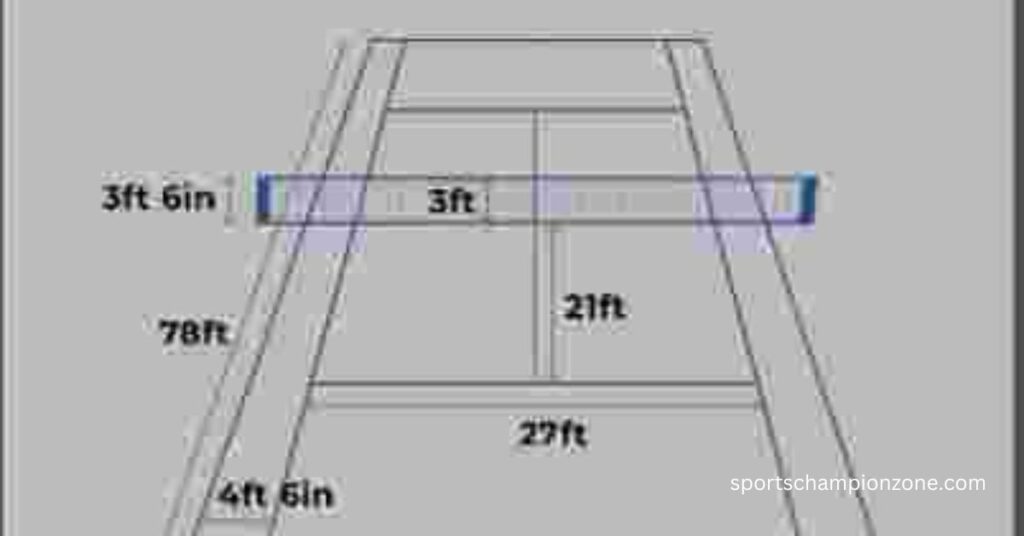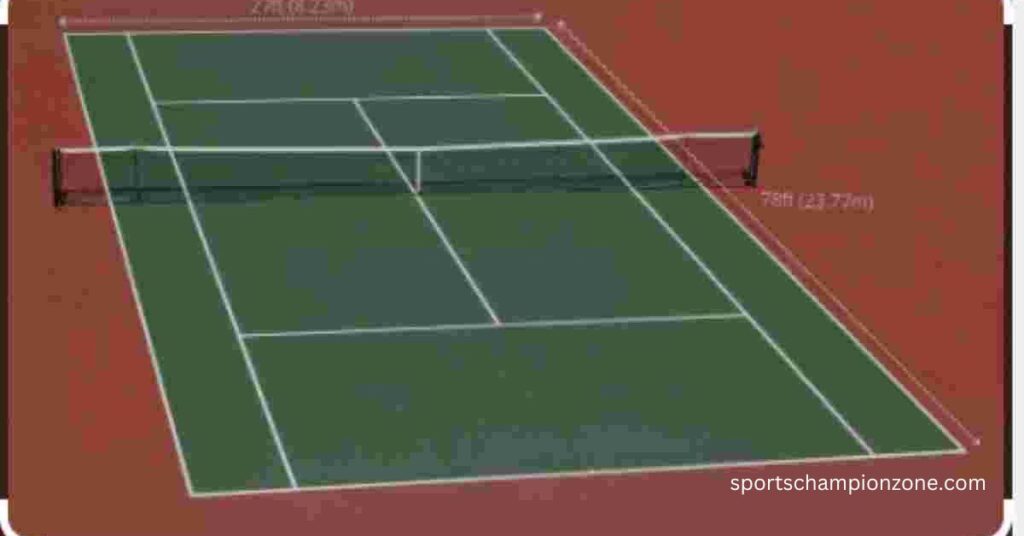The tennis court dimension in feet of a standard tennis court in feet are normally:
1: Length: 78 feet
2: Width (singles): 27 feet
3: Width (doubles): 36 feet
These dimension are normalized by the international Tennis Federation (ITF) for proficient and sporting play.
Making a tennis court dimension in feet is estimated right is really significant. It assists keep things with fairing for players and guarantees the court meets official standards. Whether it’s for a major competition or simply a tomfoolery game, getting the estimations spot on is critical. This guide gives simple ways to quantify a tennis court precisely, so it’s the ideal size and shape for playing.

Overall Tennis Court Dimension In Feet
Tennis courts dimension in feet arrive in a particular size set fair and square. Realizing these estimations is significant for players and anybody engaged with setting up a court.
Length of the Court The length of a tennis court dimension in feet is the manner by which long it is from one finish to the next. It’s 78 feet in length. Envision running from one finish to the next — that is the length of a tennis court.
Width for Singles and Double
The width of a tennis court changes relying upon whether it’s for singles or duplicates matches.
Singles Play: The single match is the court 27 feet wide. It resembles the width of a major room in a house. •
Double Play: When it’s a double match, the court is more extensive, estimating 36 feet across. That is more extensive than a singles court to fit more players.
Why It Is Matter?
Getting the court size right guarantees fair play and assists players with knowing where they ought to be during a match. Whether it’s rehearsing with companions or contending in a competition, having the right-sized court makes the game more charming for all interested parties.
Baseline and Service Boxes
The standard and service boxes are significant pieces of a tennis court dimension in feet is where explicit activities happen during a match.

Baseline: The Back Boundary
The standard denotes the back boundary of the tennis court dimension in feet. It’s like the “end line” in different games. Players start behind the standard while serving, and they need to remain inside it while hitting shots. Envision it as the line you would rather not cross during the game.
Service Boxes: Where the Action Starts
The assistance boxes are rectangular regions situated on each side of the net. They are where players should hit their serves during a highlight start the convention. This is the way they work:
1 Singles Play: In singles matches, there are two help boxes — one on the right half of the court and one on the left.
2 Double Play: For double matches, there are as yet two help boxes, yet they are more extensive separated to oblige the additional players.
Why They’re important
The benchmark and administration confines assume a pivotal part the way that focuses start and progress during a tennis match. Serving from behind the standard and landing serves inside the assistance boxes are crucial guidelines that all players should keep. Understanding these key regions assists players with knowing where to situate themselves and how to successfully execute shots. Whether serving or returning, knowing how to utilize these regions decisively can have a major effect in winning focuses and eventually, the match.
Lines and Boundaries
Understanding the lines and boundaries on a tennis court is fundamental for players to know where they can play and how focuses are scored
Baseline: The Starting Point
The standard runs lined up with the net and denotes the back boundary of the court. It’s where players start each point and where they need to remain behind while hitting shots. Consider it the line that sets the beginning stage for each play.
Service Lines: Defining the Service Boxes
Service lines are the lines that stretch out from the net to the pattern, denoting the front boundary of the help boxes. While serving, players should raise a ruckus around town inside these lines to accurately begin the point. These lines assist with characterizing the region where serves need to land to be viewed as in play.
Sidelines: Keeping Shots In
The sidelines run opposite to the net and imprint the side limits of the tennis court dimension in feet. Players need to keep their shots inside these lines to guarantee they’re in play. On the off chance that a shot terrains outside the sidelines, it’s thought of as out, and the rival procures the point.
Why They’re Important
Understanding and regarding the lines and limits on the court are critical for fair play. They decide if shots are in or out and assist players with knowing where they can stir things up around town during a match. By remaining inside these lines, players can guarantee fair and exact ongoing interaction, making tennis matches more agreeable and cutthroat for all interested parties.

The Net
The net is a focal element of the tennis court dimension in feet that isolates it into equal parts and assumes a critical part in the elements of the game.
Height and Structure
The net is raised over the ground and ranges the width of the court, partitioning it into equivalent parts. It remains at a level of 3 feet (36 inches) at the middle and 3.5 feet (42 inches) at the posts. This level moves players to hit shots over it while holding back nothing control.
Functionality in Play
The main role of the net is to challenge players with shots that require precision and artfulness. It goes about as a hindrance that players should explore during conventions, filling in as both a snag and an objective. Players expect to hit shots over the net and land them inside the limits of the adversary’s side of the court while likewise trying not to raise a ruckus around town itself. Impact and Strategy
The net impacts players’ systems, empowering them to utilize different procedures to conquer its level and width. Players might utilize different shot points, twists, and velocities to clear the net and put the ball in profitable situations on the court. Furthermore, the net assumes a urgent part in deciding the outcome of shots close to the net, like volleys and drop shots.
A Symbol of Fair Competition
The net represents the split between adversaries on the tennis court dimension in feet, addressing the test and rivalry inborn in the game. It fills in as a fair and unprejudiced appointed authority of shots, deciding the result of meetings and focuses in light of whether the ball clears its level and grounds inside the limits. At last, the net adds a component of fervor and ability to tennis matches, featuring the physicality and accuracy expected to prevail in the game.
Center Service Line
The middle help line is a fundamental component of the tennis court, directing players during serves and focuses.
Location and Purpose
Arranged at the midpoint of the court, opposite to the net, the middle assistance line partitions the court into equivalent parts. Its essential capability is to act as a source of perspective point for players while serving and situating during focuses.
Serving Reference
During serves, players should remain behind the middle assistance line to convey the ball into the adversary’s administration box. This line assists players with adjusting their position precisely, guaranteeing that serves are struck from the right beginning stage.
Positioning Guide
As well as serving, the middle help line helps players in situating themselves successfully during focuses. Players utilize this line as a visual manual for keep up with their situating comparative with the focal point of the court, empowering them to cover the tennis court dimension in feet productively and expect their rival’s shots.
Strategic Importance
Understanding and using the middle help line decisively can give players an upper hand. By situating themselves accurately comparable to this line, players can expand their court inclusion, keep a fair court presence, and execute vital shots really.
Fair Play and Accuracy
The middle help line adds to fair play by guaranteeing that players serve from steady positions and keep up with precise court inclusion during focuses. Its unmistakable stamping forestalls questions and guarantees that players comply with the standards of the game, advancing decency and respectability in tennis matches. The middle line fills in as a major component of the tennis court dimension in feet, directing players in serving and situating with accuracy. Its job in working with fair play and vital interactivity highlights its significance in the game of tennis.

Tips for Measuring a Tennis Court
Guaranteeing a tennis court dimension in feet is estimated precisely is vital for keeping up with reasonableness and adherence to guidelines. Whether setting up a court for a well dispose match or getting ready for a competition, it is crucial for knows the right estimation strategies.
Why Accurate Measurement Matters
Accurate measurement guarantees that the court satisfies official guidelines, giving players a level battleground. Whether it’s the length, width, or situation of lines, exact estimations add to fair interactivity and a positive encounter for players. gear guarantees estimations are exact and reliable.
Ensuring Consistency
Consistency in estimations is critical to guaranteeing reasonableness in interactivity. By following normalized systems and utilizing solid apparatuses, tennis court dimension in feet estimations can be repeated precisely across various areas.
Exact estimations add to player wellbeing by guaranteeing that the court aspects satisfy security guidelines. This forestalls wounds and establishes a solid climate for players to partake in the game.
How many of feet is a tennis court?
A tennis court dimension in feet is length is 78 feet long. This length is divided into main parts by a net. Each half, known as a “court,” is 39 feet long. The width of the court can change dependent upon whether it’s a singles or duplicates match. For singles facilitates, the court is 27 feet wide, while for matches organizes, it’s 36 feet wide. The lines meaning the constraints of the court are seen as a component of the court’s viewpoints.
How would you measure a tennis court?
To measure a tennis court, you’ll require an assessing tape or an assessing wheel. Start toward one side of the court and measure 78 feet for the length. This is starting with one benchmark then onto the next. Then, accepting at least for now that you’re assessing the width for singles, measure 27 feet starting with one sideline then onto the next. For copies, measure 36 feet. Ensure the lines indicating the cutoff points are associated with your assessments. This furnishes you with the exact components of a tennis court.
How many meters is a tennis court?
A tennis court is around 23.77 meters long. This length connects beginning with one benchmark then onto the following. For the width, it shifts thinking about whether it’s for singles or copies. In singles, the court is around 8.23 meters wide, while for matches, it’s around 10.97 meters wide. These evaluations guarantee the court is fittingly assessed for constant affiliation. It’s fundamental to consider these perspectives while setting up or rehearsing on a tennis court.
What is tennis court called?
A tennis court is basically called a “tennis court.” It’s the given out district where tennis matches are played. It’s commonly a rectangular surface disconnected into indistinguishable parts by a net. Players hit a ball forward and in reverse over the net, expecting to land it inside the limitations of the court. The court is discrete with lines to show its endpoints, and it’s where players battle in singles or duplicates matches, consenting to unequivocal endlessly rules of the game.
Conclusion:
Ensuring a tennis court dimension in feet is estimated precisely is indispensable for a fair and charming playing experience. By following legitimate estimation strategies and utilizing the right apparatuses, players can be sure that the court fulfills official guidelines. Precise estimations add to decency in ongoing interaction, forestall wounds, and establish a protected climate for all members. Whether setting up a court for a cordial match or getting ready for a cutthroat competition, tender loving care in estimations guarantees consistency and adherence to guidelines. In general, exact estimation of a tennis court dimension in feet improves the nature of play as fairness and safety.
If you want to more detail and better information you can also visit:
